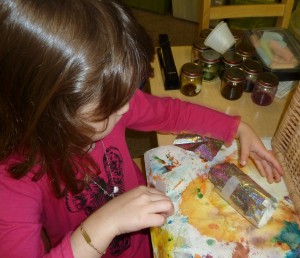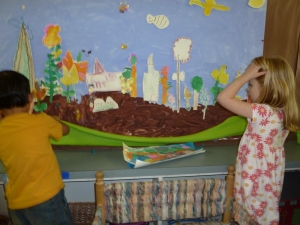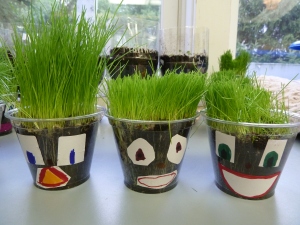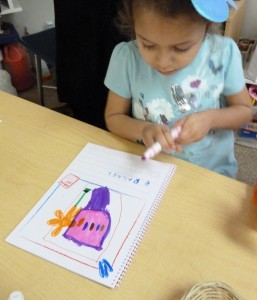This has been a very busy week. It always seems, as we draw closer to the end of the year, that the number and variety of projects we still wish to accomplish becomes insurmountable. Maybe you’ll let me keep them all for another year? Yes? Hmmm…I guess not. In that case, I’ll just fill you in on what’s been happening this week.
Our play garden has finally developed enough to add the mushrooms and some small friends for playing. My plan to use the path for a game board has been a bit challenged by the grass growth, though. On Monday, the children used scissors to help me give it a trim and I’ve been trying to keep up with weeding between the rocks, but it is still jungle-esque.
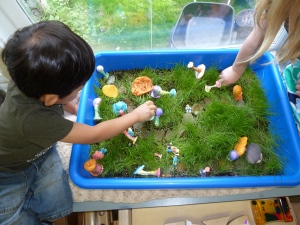
Our basil plants have grown much in the last few weeks. I think I will send them home with the children on Monday. Care and feeding should be quite easy. Simply fill the bottom of the 2-liter bottle half-way with water and set the upturned top inside the bottom. This step makes it self-watering. Place it in a sunny spot indoors or out and you’ll have yummy basil all summer.
Another activity that involves up-cycled materials used most of the water bottle caps we’ve been collecting all year. At first, I had planned for us to make some sort of outdoor musical instrument or chime. The sound of the many caps clinking together is rather pleasant. However, as I began on a test version, I realized how much a string of them resembled a caterpillar. What luck since we’re preparing for our annual Very Hungry Caterpillar play.
Each child took turns using a hammer and a short, sharp nail to pre-poke holes into all of the lids. We practiced one at a time during a Morning Meeting so that I could be sure that each child understood the procedures and safety issues that needed to be in place. We also placed the cap on a clipboard prior to hammering so that we wouldn’t damage the tables.
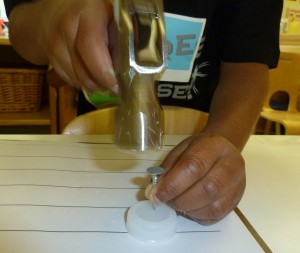
For many of the children, this was the first time they had been allowed to use a hammer. I was very impressed with the earnestness with which they approached the task. Not once all week was there a wild or dangerous moment. They took this job quite seriously.
The next step was new for many as well. They had to thread a large, plastic needle with twine and “sew” twenty of the caps together. All of the children have had many experiences with beads, but the change in mode of string delivery caused a bit of confusion. At least two students muddled through poking the twine through the holes of a couple of caps without the needle only to find that the needle was still attached near the knot at the end. Once we figured out how to hold the needle and both ends of string together in a pincer grasp, it became much easier. It was also a great opportunity for me to informally assess their ability to consistently count objects to twenty.
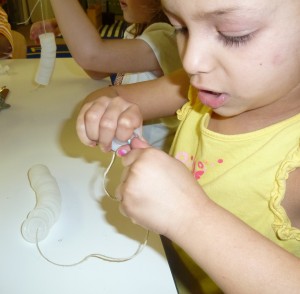
The rest of the week involved a plethora of preparation for our play [isn’t that a mouthful]. I think I’ll just allow you to wonder what those projects might have been, though. We’ll see all of you next Friday at 10:45 for our play and you can see for yourself. Remember, if it is a dry day, we will be performing outside on the playground on the stage. If it is raining, you can safely assume that we’ll be in the multipurpose room. Our family picnic will follow directly with the location to be set by the weather. So far, families have signed up to bring fruit, juice, and cookies. If anyone wants to add pretzels or other crunchy treat or any other dishes, please let me know. I ordered the sandwich rings this morning, so I’m salivating already.






